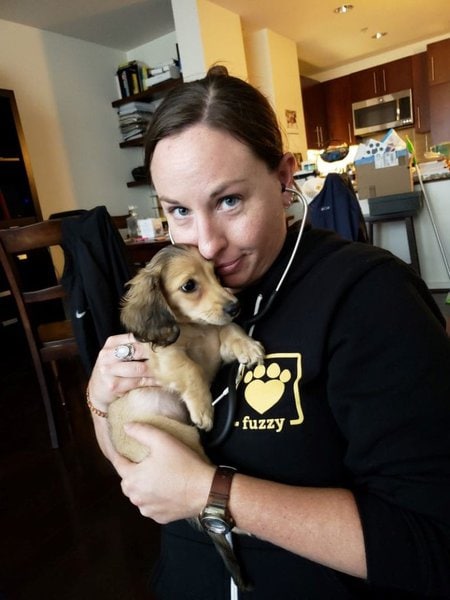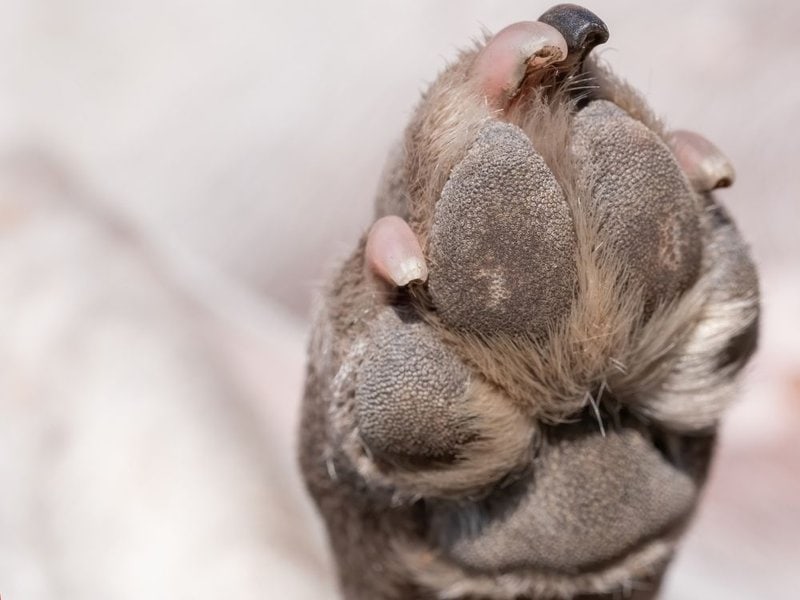If your dog is constantly licking and scratching his paws, it could be a sign of yeast infection. Yeast infections can be painful and uncomfortable for your dog, so it’s important to get him treated as soon as possible.
A yeast infection on a dog’s paw is often caused by an overgrowth of yeast. Yeast is a normal part of your dog’s skin, but it can overgrow if the skin’s pH is off balance or if there’s another health condition present. Dog paw yeast infections are often seen in dogs with allergies or other types of skin problems.
To treat dog paw yeast infection, medical, anti-fungal dog shampoos are the most effective. Coconut oil and apple cider vinegar are alternative home remedies too.
How Do I Treat A Yeast Infection On My Dogs’ Paws?
A yeast infection can make your dog pretty miserable from the constant itching.
Fortunately, there are plenty of effective remedies that you can use to treat a yeast infection on your dog’s paws.
Medicated Shampoos
Over-the-counter medicated anti-fungal dog shampoos are easily the best treatment for dog paw yeast infection.
Typically, these shampoos contain ketoconazole, which is an antifungal medication. When using this type of shampoo, be sure to follow the directions on the package. In most cases, you will need to leave the shampoo on your dog’s paw for at least five minutes before rinsing it off.
Another simple treatment is to use anti-fungal dog wipes on your dog’s paws after walks or whenever they get wet.
Just be sure to choose wipes that are specifically designed for dogs, as human wipes can contain harsh chemicals that can be harmful to your pup.
Hydrogen Peroxide
A hydrogen peroxide soak is another effective home remedy to keep dog paw yeast infection at bay.
Simply mix a cup of hydrogen peroxide and 1 cup of white vinegar in a gallon of water. Soak your dog’s feet in this solution.
Do not rinse the solution, simply pat dry.
Apple Cider Vinegar
Apple cider vinegar is a potent anti-fungal which makes it a great remedy for yeast infections. You can simply mix equal parts of apple cider vinegar and water and use it as an after-bath rinse on your dog’s paws.
Coconut Oil
Coconut is a great remedy for yeast infections. It is rich in antioxidants and a host of essential vitamins that boost its antifungal properties.
Coconut oil is also rich in fatty acids that promote quick healing of the skin.
Raw Paws Organic Coconut Oil is an excellent soothing balm that is formulated to help treat dog paw yeast infection. It not only provides relief from the constant itching, but it will also keep your dog’s skin moisturized which will help to prevent scabbing.
How Do I Care For My Dogs With Yeast Infection In Their Paws?
Keep Your Dog’s Paws Clean and Dry
Your pup’s bound to get their paws dirty throughout the day. Dirt and moisture make the perfect breeding ground for yeast so keeping your dog’s paws clean is essential.
A dog with a yeast infection should be bathed twice a week.
If the yeast infection is in only one area, such as the paws, you can clean the affected area only. For this, you will require a medicated shampoo. Always ensure that you leave the shampoo on for no less than 10 minutes before rinsing it off.
A medicated shampoo like the Veterinary Formula Clinical Care Antiparasitic & Antiseborrheic Medicated Dog Shampoo is one of the most effective ways to keep yeast infections at bay. This shampoo is formulated to be fast-acting ensuring that your pooch gets relief from his symptoms in no time.
Watch Your Dog’s Diet
A poor diet can lead to dog paws yeast infection so making sure your pooch is on a healthy diet is important.
Start by limiting unhealthy high-carb treats which may exacerbate yeast infections.
Nutrient-dense foods like Pet Plate’s gluten and grain-free meals are an ideal option for dogs prone to yeast infections. The low-carb diet works great since gluten and unhealthy carbs can increase susceptibility to yeast infections.
Probiotic yogurts are not just great for people. Dogs will also benefit from probiotics which help fight fungal infections. Include yogurt in your dog’s diet to help treat yeast infection.
Don’t forget that the constant itching from dog paw yeast infection can cause your pooch plenty of anxiety. You will, therefore, need a healthy calming treat and you cannot go wrong with the nutritious GOODGROWLIES Calming Hemp Treats. These calming treats will help to provide relief from the constant itching resulting in a calmer, happier dog.
How Do I Know If My Dog Has A Yeast Infection On His Paws?

Yeast infections are pretty common in dogs but if you are not keen you may miss the symptoms. So, what exactly does a yeast infection in dogs look like?
Licking And Scratching
One of the easiest symptoms of yeast infection to spot is constant licking and biting of paws.
Yeast infections tend to be itchy and you will find that your dog is constantly licking and chewing its paws to ease the discomfort.
If you notice that your pooch can’t seem to stop licking its paws, you may want to check for signs of yeast infections. Some dogs may resort to biting their paws in an attempt to ease the itching.
Inflammation
Yeast infections will often cause inflammation in your dog’s paws.
You will notice that your dog’s toes will turn red and become swollen. This inflammation can make walking difficult for your pooch and they may avoid walking as a result.
If the yeast infection is not treated in time the inflammation may lead to scabbing.
Bad Odor
It is not uncommon for dogs that have yeast infections to have an unpleasant smell.
If you notice your dog’s paws suddenly start to smell like Fritos, that is a pretty good indication of a paw yeast infection.
Restlessness
Yeast infections can be quite uncomfortable for your pooch. The constant itching will make your pup restless and they may have a hard time staying calm.
What Causes Yeast Infection In Dogs Paws?
Yeast infections can last up to 6 weeks in dogs and may require long-term treatment to resolve completely.
Just like any other dog skin condition, prevention is better than cure so it is important to understand what factors will make your pooch prone to dog paw yeast infections.
Yeast infections are pretty common in dogs and can be caused by a variety of factors including:
- Poor diet
- Lack of proper hygiene
- Compromised immunity
- Skin parasites
- Hypothyroidism
- Certain cancers
- Prolonged antibiotic use
- Skin allergies
Poor Diet

Unhealthy treats, too many carbs, and unhealthy human foods are all common causes of yeast infections in dogs. Keeping your dog on a nutrient-dense, low-carb diet is one way to help keep yeast infections at bay.
Poor Hygiene
Dog paws get pretty dirty and if they are not cleaned regularly, they will become the perfect breeding ground for yeast.
Always clean your dog’s paws after long walks and bathe your dog regularly to keep his skin clean.
Moisture also promotes the growth of yeast so make sure that you pat your dog’s skin dry after bathing to keep it moisture free.
Underlying Health Conditions
Cancer, hypothyroidism, bacterial infections, and skin allergies can also lead to yeast infections.
It is important to consult your vet when your dog has a yeast infection since it may be a symptom of a bigger health issue.
Prolonged Antibiotic Use
If your pooch is on antibiotics, they may become more susceptible to yeast infections, especially after prolonged use.
Should You Take Your Dog To See A Vet For Yeast Infection?
In cases of mild yeast infections, the symptoms can be relieved within a week by using medicated shampoos and other home remedies.
However, if your dog’s symptoms do not show any signs of abating, consult your vet for proper diagnosis and treatment.
If your dog has recurrent bouts of yeast infections you need to see a vet so that they can rule out any underlying conditions. It is always important to note that a yeast infection can be a symptom of a bigger health issue.
Take your dog to the vet if you have tried OTC medicated shampoos and home remedies with no success.

If dog paw yeast infection is left untreated it can lead to scabbing and secondary bacterial infections. This can be extremely uncomfortable for your dog and may lead to difficulty in walking.
Untreated yeast infections can also spread from the paws to the rest of the body, making the condition even worse for your dog.
Older dogs and dogs with compromised immune systems due to diseases such as cancer may have a hard time recovering from yeast infections. In these cases, it is better to see a vet for proper treatment instead of banking on home remedies.
Ultimately, your pooch’s wellbeing is dependent on how fast you intervene in case of infections. Even a mild yeast infection can become troublesome if not treated in time. Consulting a vet is always the safest choice when it comes to keeping your pooch in good health.
Related Questions
Will Yeast Infection On Dogs Go Away On Its Own?
No, a yeast infection on dogs requires treatment. Mild infections can be treated at home using medicated shampoos and antifungal home remedies such as vinegar. Consult your vet for severe dog yeast infections.
Is Yeast Infection On Dogs’ Paws Contagious?
No, yeast infection on a dog’s paws is not contagious. Your dog cannot contract a yeast infection from another dog. This condition is often linked to poor diet, unhygienic conditions, and in some cases underlying health issues.
What Can I Put On My Dog’s Paws To Stop Licking?
You can put anti-lick sprays on your dog’s paws to stop them from licking. These sprays help to relieve itching and as a result help curb incessant licking. Spraying your dog’s paws with an Apple Cider Vinegar solution is also going to relieve itching and minimize licking.





